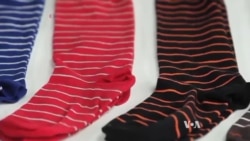America has lost 3.8 million manufacturing jobs since 2000 according to the U.S. Census Bureau. The apparel industry was especially hard hit, as more and more U.S. clothing companies turned to low wage workers in Indonesia, Bangladesh and Vietnam.
Yet many of those brands advertised themselves as being ‘all-American.’ That didn’t sit well with Joshua Steinman, Turner Swicegood and Jay Gaul. The three friends wanted to create something that was actually what it purports to be; an all-American product that is made entirely in the USA by American workers.
“We don’t really make a lot of things in this country anymore," Swicegood said. "It’s a service-based economy; it’s a financial-based economy. There’s not a lot of things that you can touch and feel that are being made by American hands and so we wanted to reach back to that tradition and be a part of reviving that.”
So three years ago the young entrepreneurs formed a small company to make luxury American dress socks with the finest quality materials available in the U.S., in vibrant, eye-catching colors and simple designs for the modern man - and woman.
Today, their one-of-a-kind creations are being manufactured at an American knitting mill in North Carolina, which is just one of a seven-step manufacturing process that has been integral to the making of their socks, and the fulfillment of their collective dreams.
Steinman, an active duty U.S. naval officer, came up with the idea of luxury socks during a tour of duty overseas.
“For a while I had to work wearing a suit and tie every day and I wanted to wear something that was going to make me stand out, so I made sure to always wear flashy socks to work,” he said.
So he got the reputation as the person who always wore exciting socks and came to be known as “the sock guy.”
But he didn’t actually like any of the socks that he wore because he said, they kept falling down.
“I felt they weren’t made especially well,” he said, “so after that assignment was over, I started thinking about what would it mean for me to get socks that I really did like, and that was the genesis of Penance Hall.”
Two guiding principles drive the company’s philosophy.
Their socks have to be made with the finest quality materials and, although they could be produced more cheaply overseas, have to be made in America.
So every component that goes into their product - from the sheep that provide the ultra-fine wool, to the custom-formulated dyes, to the factories that weave them into socks - is all American.
Even the boxes that the socks are packaged in are made in the U.S.A., in a factory in Pennsylvania.
“So we paired the best machines in the world with the best fibers in the world and it just so happens that we were able to do both of those things in America,” said Steinman.
The partners financed the bulk of their enterprise through an Internet site called Kickstarter, which allows people to crowd-fund businesses.
“On Kickstarter we said, ‘This is what we’re trying to make,’” Steinman said. “We told the story of the socks and then gave people the opportunity to pledge a small amount of money in exchange for socks in the future.”
Their message resonated with the global online audience and - with help from a slick promotional video - they raised over $50,000 in a single month; about $13,000 more than their stated goal, making it one of the most successful fashion projects in Kickstarter history, according to the partners.
The funds allowed them to produce 5,000 pairs of socks.
That first run of Penance Hall dress socks is ready to be shipped to about 1,000 customers worldwide who pledged during the Kickstarter campaign and new customer orders will be filled in the coming weeks.
“We wanted to maintain a strong brand identity that was centered in American production,” said Swicegood, “and we wanted to maintain control of the company by not taking outside investment…instead by doing crowd funding via Kickstarter, we were allowed to do that.”
“It was really exciting to see that we had customers from all across the U.S. but then also all across the world who are going to get these socks in the next couple of months,” he added.
If their pricey socks sell well online, the partners hope to expand their clothing line and make them available in stores in the U.S. within the next 10 years.









